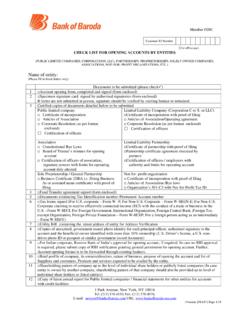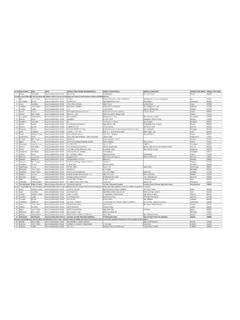Transcription of ADMISSION MANUAL 2018-19 - msubaroda.ac.in
1 THE MAHARAJA SAYAJIRAO UNIVERSITY OF BARODA ADMISSION MANUAL 2018-19 THE MAHARAJA SAYAJIRAO UNIVERSITY OF BARODA (Accredited Grade A by NAAC) Look around you, and mark the success of those who have distinguished themselves! You will find that it is not book-knowledge alone, but solid worth of character, which has led to their success . Maharaja Sayajirao Gaekwad III A Great Visionary and Founder of the University Baroda College had a great reputation when it began its career in the last century. Now that it is a part of the Maharaja Sayajirao University, I hope it will outshine the past record . Shrimati Hansa Mehta The First Vice-Chancellor of the Maharaja Sayajirao University of Baroda CONTENT SR# DESCRIPTION 1 Vision & Mission of The Maharaja Sayajirao University of Baroda 2 Unique Features of the University 3 Background and Legacy of the University 4 Profile of the University 5 Faculties, Constituent Colleges, Institutes & Research Centers 6 Aims and Objectives of the University 7 Graduate Programmes after 8 List of Programmes offered by the University 9 ADMISSION Process Flow Chart 10 Faculty wise Programme List 11 Rules for Refund of Fees NOTE: Click on Description to go to Particular Page.
2 VISION OF THE MAHARAJA SAYAJIRAO UNIVERSITY OF BARODA The progress of a nation requires that its people should be educated. Knowledge is a necessity of man. It instills in him a desire to question and to investigate, which leads him on the path of progress .. Education, in the broadest sense, must be spread everywhere. With this end in view, I started various reforms in my state. Progress can only be achieved by the spread of education. Co-operation is necessary to achieve any worthy end, and this readiness to co-operate will not be found in people if they are not educated. Maharaja Sayajirao Gaekwad III MISSION OF THE MAHARAJA SAYAJIRAO UNIVERSITY OF BARODA Promoting and enhancing high standards of teaching learning and research for an all-round development of students. Providing a learning environment that nurtures critical reflections, exchange of ideas and innovation among students to help them realize their optimum potential.
3 Increasing access to education by all sections of the society. Relating knowledge to the contemporary socio-economic needs and moral concerns Building mutually enriching linkages with the society and its institutions. Go to Content UNIQUE FEATURES OF THE MAHARAJA SAYAJIRAO UNIVERSITY OF BARODA Only residential & unitary state university in Gujarat with English as medium of instruction Sprawling campus with heritage buildings and landscaped gardens Serene majestic structure with an Indo-Saracenic style dome, the second largest in Asia Wi-Fi enabled Campus Online ADMISSION process Catering to local, regional and national needs with global outlook Highly qualified teaching faculty Healthy teacher-student-staff ratio Cosmopolitan nature of students and teachers community Wide Spectrum of courses from kindergarten to Interdisciplinary and multidisciplinary nature of courses Wide choice of disciplines and courses with a choice based credit system approach Use of ICT in the teaching-learning and evaluation processes Rich and diverse collection of information resources in the library system Placement cells in most Faculties.
4 Apart from the University placement cell Advanced research units and facilities catering thrust areas of National Importance National and International collaborations and linkages Generation of funds through research and consultancy Outreach programmes for societal needs Orientation towards societal and environmental awareness Illustrious alumni holding high positions in various professions and sectors Democratic nature of administrative functioning Optimum use of infrastructural facilities Collection of rare and old manuscripts Go to Content BACKGROUND AND LEGACY OF THE MAHARAJA SAYAJIRAO UNIVERSITY OF BARODA The Maharaja Sayajirao University of Baroda is recognized as one of the premier institutions of higher learning and research in the country. Since its inception in1949, the University has demonstrated a keen interest and a commitment to the sustenance and promotion of an environment, favourable to the growth and development of academic excellence a commitment that forms a part of the rich legacy of the institution.
5 Educational institutions which preceded the Maharaja Sayajirao University and which went on to forming a part of its foundational legacy, included the Baroda College , one of the oldest centers of learning in Western India, founded in 1881 by His Highness Maharaja Sayajirao Gaekwad III. The enlightened ruler in 1909 established the Kala Bhavan , which consisted of seven schools: (1) School of Art, (2) School of Architecture, (3) School of Mechanical Technology, (4) School of Chemical Technology, (5) School of Pedagogy, (6) School of Agriculture, and (7) Practical School. In an attempt to further promote educational endeavor and evolve a University atmosphere in Baroda, the First Commission was appointed in 1909 by the Government of Baroda. The major recommendation of the Commission was to expand the activities of the Baroda College by establishing additional chairs in new branches of knowledge.
6 Thus, Chairs of Comparative Religion and Household Science were instituted, thereby carving out untrodden paths in higher education. The question of establishing a University at Baroda engaged the attention of the Government of the State of Baroda and its educational advisors much before the establishment of regional Universities and the need for decentralization, recognition and reconditioning of higher education had taken roots in the country. As a result, the Baroda University Commission was appointed in 1926, which submitted a comprehensive report, strongly recommending an immediate establishment of a University at Baroda. Several institutions for higher education were added during the two decades that followed. First and the foremost was the Sayaji Jubilee Institute of Science, established in 1933, to commemorate the Golden Jubilee Celebrations of the coronation of Sir Sayajirao Gaekwad III.
7 The other institutions added were the Secondary Teachers Training College (1935), Pratapsinh College of Commerce and Economics (1942), Oriental Institute, Sanskrit Mahavidyalay, College of Indian Music, Department of Archaeology, the Museum and the Picture Gallery. His Highness Maharaja Pratapsinhrao Gaekwad pursued the idea of establishing a University and appointed a committee in 1947. On the recommendation of the committee, the Government of Baroda, in its order No.(R) 169-39 dated 21st February 1949, decided to establish a Residential University at Baroda. The bill for establishment of the University was passed by the Legislative Assembly and received the assent of His Highness Maharaja Pratapsinhrao Gaekwad on April 29, 1949 & the Maharaja Sayajirao University of Baroda came into existence on April 30, 1949. Go to Content PROFILE OF THE MAHARAJA SAYAJIRAO UNIVERSITY OF BARODA The Maharaja Sayajirao University of Baroda, originally founded in 1881 as the Baroda College is a premier unitary residential University, established on 30th April, 1949.
8 It is a state University with English as its medium of instruction, having 13 Faculties, 3 Constituent Colleges, 2 Institutions and 8 Centers of Specialized Studies, wherein more than 37,295 students pursue higher studies, under the care and supervision of 1112 teaching (662 permanent) and 1190 permanent supporting staff members. It houses 89 departments spread over 6 campuses (2 rural and 4 urban) covering 275 acres of land including a built up area of 418500 sq. mt. There are 16 hostels (12 Boys and 4 Girls), which accommodates about 4103 students. There are 475 residential quarters too for teaching and non-teaching staff. The University offers a wide range of course, giving opportunity for education from early childhood to Ph. D. The preschool Chetan Balwadi is a part of the department of Human Development and Family Studies at the Faculty of Family and Community Sciences, and Experimental School, imparting education from Std.
9 I to XII, is monitored by the Faculty of Education and Psychology. Applied Science subjects, like Applied Mathematics, Applied Chemistry and Applied Physics are separate departments under the Faculty of Technology and Engineering and have interactive progressive collaborations with the Faculty of Science. It is one of the few Universities in the country offering research opportunities in the Ancient Indian Traditions of India at the Baroda Sanskrit Mahavidyalaya and Indian Classical Vocal and Instrumental Music; Bharatnatyam and Kathak Dances at the Faculty of Performing Arts; and Painting, Sculpture and Art History in the Faculty of Fine Arts; Preservation of Ancient Indian Literature and Vedic Traditions at the Oriental Institute; and an extraordinary collection of excavations, including relics of Lord Buddha at the Department of Archaeology and other rare collections are some of the salient features.
10 The University also offers courses in emerging areas like Nanotechnology, Petroleum Geology, Medical Biotechnology, Bio Informatics, Disaster Management, Embedded Systems, Packaging, Engineering Welding Technology etc. Our University also has expertise in the latest technological innovations at the Centre for Biotechnology, Genome Research Centre, Bio-informatics network, Centre for Microbial Genomics and the latest, the Centre for Molecular Genetics. The University offers around 98 postgraduate courses, 66 programmes, 39 post graduate Diploma courses and 88 undergraduate courses with an option of 347 programmes in 92 subjects. It also offers 11 certificate programmes and 3 post diploma certificate programmes. As many as 205 students are currently enrolled in programmes across various departments, of which 33% of the students are from outside Gujarat State.






